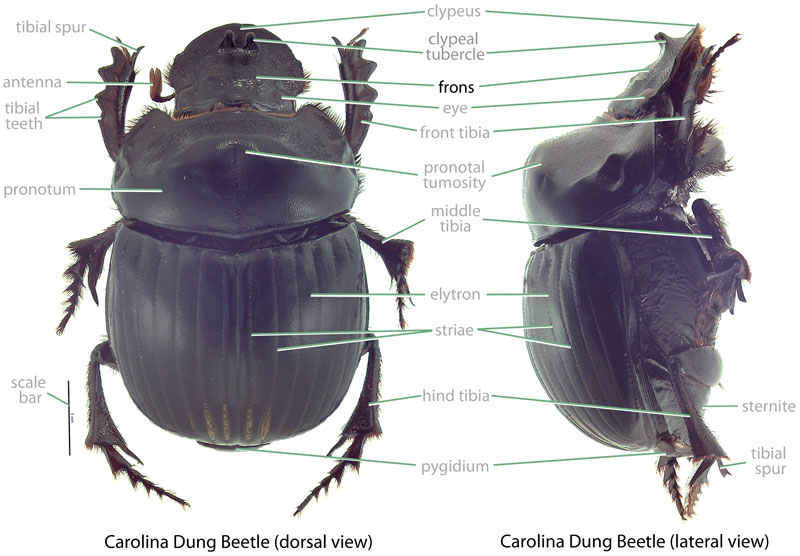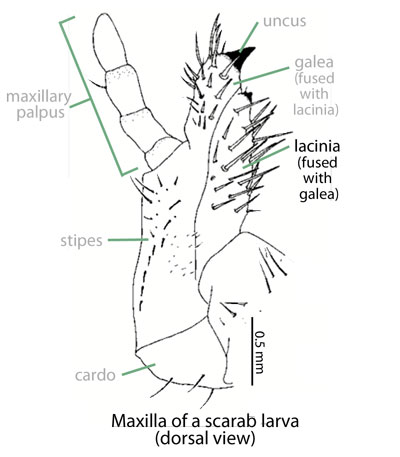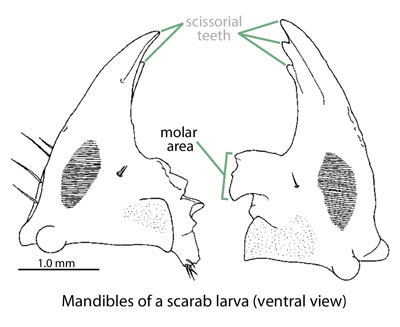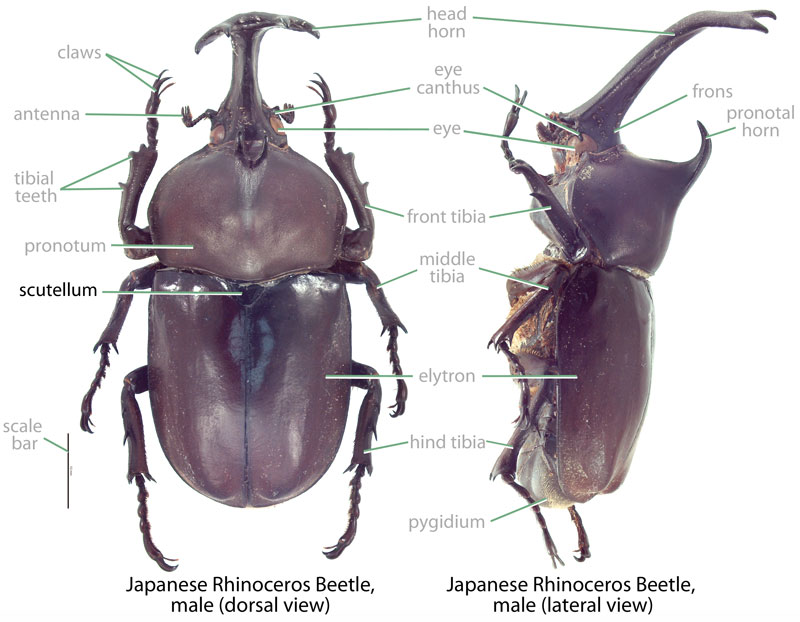Pest
Pasadena masked chafer, southwestern masked chafer
Family: Scarabaeidae Subfamily: Dynastinae Genus: Cyclocephala Species: Cyclocephala pasadenae (Casey, 1915)
none available
Total body length 12.0–14.0 mm (0.47–0.55 in). Body elongate oval. ElytraElytra:
the hardened and chitinous wing-cover of a beetle that protect and overlie the flight wing
and pronotumpronotum:
the dorsal surface of the thorax
 tan to golden-brown in color; clypeusclypeus:
tan to golden-brown in color; clypeusclypeus:
part of the head anterior to the frons; the most anterior portion in dorsal view
 and fronsfrons:
and fronsfrons:
part of the head generally positioned between the eyes (posterior to the clypeus and anterior to the vertex) and visible dorsally
 black to dark brown. Head lacking horns or tubercles. Pronotumpronotum:
black to dark brown. Head lacking horns or tubercles. Pronotumpronotum:
the dorsal surface of the thorax
 lacking horns or tubercles. Elytral lacking obvious striaestriae:
lacking horns or tubercles. Elytral lacking obvious striaestriae:
a longitudinal depressed line or furrow, often formed from numerous punctures that extends the length of an elytron
 . Lateral margin of front tibiatibia:
. Lateral margin of front tibiatibia:
a segment of the leg articulated with the tarsus and femur
 with 3 teeth. Claws of front tibiatibia:
with 3 teeth. Claws of front tibiatibia:
a segment of the leg articulated with the tarsus and femur
 noticeably more robust in males than females.
noticeably more robust in males than females.
(Ritcher, 1966Ritcher, 1966:
Ritcher P. 1966. White grubs and their allies: a study of North American scarabaeoid larvae. Oregon State University Monographs, Studies in Entomology 4: 1-219.): Grub C-shaped, not hump-backed, cylindrical, whitish. Maxillamaxilla:
set of paired mouthparts located posterior to the mandibles
with galeagalea:
outer branch or lobe of the maxilla
 and lacinialacinia:
and lacinialacinia:
inner portion of the maxilla fused or nearly so. Lacinialacinia:
fused or nearly so. Lacinialacinia:
inner portion of the maxilla of maxillamaxilla:
of maxillamaxilla:
set of paired mouthparts located posterior to the mandibles
with 3 well developed unciunci:
in scarab larvae, a hooked process on the distal margin of the maxilla
 . Maxillary stridulatory teeth truncatetruncate:
. Maxillary stridulatory teeth truncatetruncate:
appearing cut-off or suddenly shortened
. Inner, concave surface of mandiblemandible:
The crushing or chewing portion of an insects mouthparts
 , distaddistad:
, distaddistad:
oriented away from the body or the point of articulation with body
of the molar areamolar area:
grinding area of the mandible, behind scissorial area
 , smooth. Head yellow-brown to light reddish-brown, lacking coarse punctures. Dorsaldorsal:
, smooth. Head yellow-brown to light reddish-brown, lacking coarse punctures. Dorsaldorsal:
of or relating to the upper surface; opposite of ventral
surface of last antennal segment with 2–5 sensory spots. Legs 4-segmented. Spiraclesspiracles:
opening on the abdomen or thorax through which air enters and exits the body
 of first 6 abdominal segments similar in size. ScutellaScutella:
of first 6 abdominal segments similar in size. ScutellaScutella:
the triangular portion of the thorax between the bases of the elytra
 of front and middle sections of thorax each with 2 setaesetae:
of front and middle sections of thorax each with 2 setaesetae:
small, hair-like structure
. Anal opening transversetransverse:
extending horizontally across a surface
, straight or slightly curved. PlegmatiaPlegmatia:
in scarab larvae, a paired, lateral region with a somewhat sclerotized surface bordered by marginal spines with acanthoparia
 absent.
absent.
Southern U.S., northern Mexico. This species is known from the southern half of the U.S. (Hardy, 1991Hardy, 1991:
Hardy A. 1991. A catalog of the Coleoptera of America North of Mexico: family Scarabaeidae, subfamilies Rutelinae and Dynastinae. USDA Agriculture Handbook 529-34b. full text (accessed 2015)). It is most common in the southwestern states (Ratcliffe and Paulsen, 2008Ratcliffe and Paulsen, 2008:
Ratcliffe B and Paulsen P. 2008. The scarabaeoid beetles of Nebraska (Coleoptera: Scarabaeoidea). Bulletin of the University of Nebraska 22: 138-248.) and is also known from northern Mexico (Ratcliffe et al., 2013Ratcliffe et al., 2013:
Ratcliffe B, Cave R, Cano C. 2013. The Dynastinae scarab beetles of Mexico, Guatemala, and Belize (Coleoptera: Scarabaeidae: Dynastinae). Bulletin of the University of Nebraska 27: 211-13.).
Larvae are associated with turf grasses (Jameson et al., 2009Jameson et al., 2009:
Jameson M, Oishi D, Ratcliffe B, McQuate G. 2009. Two additional invasive scarabaeoid beetles (Coleoptera: Scarabaeidae: Dynastinae) in Hawaii. Proceedings of the Hawaiian Entomological Society 41: 25–30. full text (accessed 2015)).
In Nebraska, this species has a single generation per year, with adults active from June to October. Adult abundance peaks strongly in July (Ratcliffe and Paulsen, 2008Ratcliffe and Paulsen, 2008:
Ratcliffe B and Paulsen P. 2008. The scarabaeoid beetles of Nebraska (Coleoptera: Scarabaeoidea). Bulletin of the University of Nebraska 22: 138-248.). Females lay eggs in the soil, with larvaelarvae:
the immature form of an insect; in scarabs, also called grub or white grub; preceded by the egg stage, followed by the pupal stage
 feeding on both grass roots and organic soil debris. Adults do not appear to feed (Ritcher, 1966Ritcher, 1966:
feeding on both grass roots and organic soil debris. Adults do not appear to feed (Ritcher, 1966Ritcher, 1966:
Ritcher P. 1966. White grubs and their allies: a study of North American scarabaeoid larvae. Oregon State University Monographs, Studies in Entomology 4: 1-219.).
Moderate. The pest potential of this species is somewhat unclear. Some sources state that larvaelarvae:
the immature form of an insect; in scarabs, also called grub or white grub; preceded by the egg stage, followed by the pupal stage
 rarely occur in sufficient density to cause serious turf damage (Ratcliffe and Paulsen, 2008Ratcliffe and Paulsen, 2008:
rarely occur in sufficient density to cause serious turf damage (Ratcliffe and Paulsen, 2008Ratcliffe and Paulsen, 2008:
Ratcliffe B and Paulsen P. 2008. The scarabaeoid beetles of Nebraska (Coleoptera: Scarabaeoidea). Bulletin of the University of Nebraska 22: 138-248.). Other sources describe it as among the most destructive turf pests in its range (Jameson et al., 2009Jameson et al., 2009:
Jameson M, Oishi D, Ratcliffe B, McQuate G. 2009. Two additional invasive scarabaeoid beetles (Coleoptera: Scarabaeidae: Dynastinae) in Hawaii. Proceedings of the Hawaiian Entomological Society 41: 25–30. full text (accessed 2015)). In its small Hawaiian range, this species has been associated with visible turf damage, some caused indirectly when birds dig for grubs (Jameson et al., 2009Jameson et al., 2009:
Jameson M, Oishi D, Ratcliffe B, McQuate G. 2009. Two additional invasive scarabaeoid beetles (Coleoptera: Scarabaeidae: Dynastinae) in Hawaii. Proceedings of the Hawaiian Entomological Society 41: 25–30. full text (accessed 2015)).
Established. Cyclocephala pasadenae is known only from a Waikaloa golf course on Big Island, where it was first recorded 2007 (Jameson et al., 2009Jameson et al., 2009:
Jameson M, Oishi D, Ratcliffe B, McQuate G. 2009. Two additional invasive scarabaeoid beetles (Coleoptera: Scarabaeidae: Dynastinae) in Hawaii. Proceedings of the Hawaiian Entomological Society 41: 25–30. full text (accessed 2015)). Anecdotal evidence from the golf course staff suggest it may have established as early as the mid 1990's (Jameson et al., 2009Jameson et al., 2009:
Jameson M, Oishi D, Ratcliffe B, McQuate G. 2009. Two additional invasive scarabaeoid beetles (Coleoptera: Scarabaeidae: Dynastinae) in Hawaii. Proceedings of the Hawaiian Entomological Society 41: 25–30. full text (accessed 2015)).
Not established or recorded. There are no records of this species from Guam.
This species is attracted to lights at night (Ratcliffe and Paulsen, 2008Ratcliffe and Paulsen, 2008:
Ratcliffe B and Paulsen P. 2008. The scarabaeoid beetles of Nebraska (Coleoptera: Scarabaeoidea). Bulletin of the University of Nebraska 22: 138-248.) and could be attracted to well lit ports and airports. This would allow for hitchhiking on marine or air cargo. Because eggs are laid in turf grasses, it is possible that eggs or larvaelarvae:
the immature form of an insect; in scarabs, also called grub or white grub; preceded by the egg stage, followed by the pupal stage
 could be transported in shipments of commercial sod. Cyclocephala pasadenae should be regarded as a potential invasiveinvasive:
could be transported in shipments of commercial sod. Cyclocephala pasadenae should be regarded as a potential invasiveinvasive:
a species that has recently arrived to a new location, usually via human activity, causing notable economic and/or ecological damage
threat to the other U.S. Pacific territories and the Caribbean.
Cyclocephala pasadenae is the only member of its genus known from Hawaii. It is superficially most similar to another turf pest, Anomala orientalis (oriental beetle). These species are easily separated by size (C. pasadenae at 12.0–14.0 mm [0.47–0.55 in] versus 7.0–11.0 mm [0.28–0.43 in] in A. orientalis) and examination of the front tarsitarsi:
the distal part of an insect leg attached to the tibia and consisting of five sub-segments in scarab beetles; bears the tarsal claws
(C. pasadenae with 3 teeth along the lateral margin of the front tibiatibia:
a segment of the leg articulated with the tarsus and femur
 versus 2 teeth along the lateral margin in A. orientalis).
versus 2 teeth along the lateral margin in A. orientalis).
Cyclocephala mexica Martínez, Ochrosidia arizonica Casey, Ochrosidia facilis Casey, Ochrosidia melina Casey, Ochrosidia ovulata Casey, Ochrosidia pasadenae Casey, Ochrosidia pusilla Casey, Ochrosidia validiceps Casey
Report your observation of this species at our iNaturalist project.